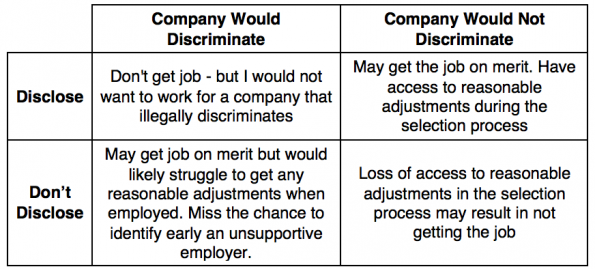Disclosure Dilemma
A person with an invisible disability may find it difficult to talk about their condition and the daily challenges they face. For the neurodiverse specifically, they may fear the stigma attached to their condition. Previous neurodiversity disclosure may have resulted in a reluctance to accept from a previous boss. They may have been dismissed with remarks like you can’t be dyslexic because you’re smart. People with hidden disabilities may fear the fact that nearly 4 in 10 people think of disabled people as less productive than non-disabled people. There are many factors that influence a decision to disclose.
I am open about my dyslexia and dyspraxia. For me, the benefits outweigh the costs. I encourage others to be open too. However, I am not so nieve to think it is without risk.
For many hidden disabled there is a constant risk-based assessment on disclosing their condition. Will the person think less of me? Would it be thought I am using it as an excuse? Will they treat me differently? In the neurodiversity community, many who have professional jobs have adopted the LBGT term of coming out to discuss their considerations of disclosing as autistic or dyslexic.
Why Disclose Neurodiversity?
There is no compulsion for a neurodivergent individual to disclose their condition. However, without disclosure, it’s hard to get adjustments that may help. Adjustments to which you are legally entitled. If you don’t need any assistive tech to do your job you may think there are no benefits to disclosure – read on.
There is research which shows that the burden of concealing a disability creates strain in social and work situations. This might negatively affect health and well-being (Chaudoir & Quinn, 2010). In contrast, disclosure relieves the strain of hiding the condition. It increases the likelihood that the person will find and develop a social support network with others who might have similar conditions or experiences.
Despite the potential benefits of disclosing, research suggests that individuals with invisible disabilities often do not disclose their conditions. This is especially true if they are young and have recently acquired or discovered the disability (Baldridge & Swift, 2013). This can get really complicated when individuals are out in some communities but not to others. It can create an intricate web of workplace interactions.
It may be fair to conclude if you are not struggling then there is nothing to disclose. I’ve seen this play out a few times. Things are OK until they are not and then its hard to get the help needed to get back on track. It’s much easier to lay the groundwork so there is an awareness.

What does disability disclosure look like?
My dyslexia / dyspraxia disability disclosure to each new line manager is really light touch. I explain that I’m dyslexic and dyspraxic and briefly cover how that can impact my work. I follow with the fact I have a really poor short term memory so if they ask me to do something and I don’t write it down then that is an indication I’ve not clocked there is something for me to do. If the conversation is going well I’ll explain my written work product is not great so I prefer speaking to people than writing. As I’ve progressed in my career I have found this easier. This is because I’m being managed by more talented managers and because once you get reasonably senior people starting to look at your achievements rather than your struggles.
When I attend a professional exam my neurodiversity disclosure is normally a scan of my phycologist assessment. Professional bodies rightly don’t grant accommodations without proof of need. Fortunately, they still accept my 20+ year-old assessment.
Disclosure and job hunting
When I applied to work after university in 2000 there was a scheme called two ticks. Under this scheme ticking the relevant box on application forms granted an application a little more consideration. I can’t remember the specifics but the thing that got my tick was the fact it guaranteed an interview to applications meeting the criteria for the job. Given my struggle with spelling and written brevity, this was a godsend.
The Two Ticks scheme has been replaced by the Disability Confident scheme which seeks to ensure employers are making the most of the talent marketplace.
Like the previous scheme, level 2 Disability Confident employers commit to offering an interview to disabled people who meet the minimum criteria for the job.
The Loughborough University has more on disclosure during a job hunt.
Some may worry about how their condition might reflect poorly on them in the selection process. Personally, I don’t think I could work effectively in the type of organisation that did not recognise my difference and was unwilling to accommodate it.

What can organisations do to encourage neurodiversity disclosure?
Reducing the burden that concealment brings is a good thing for the individual and the organisation. However, the route to it is not through directly encouraging people to disclose. The way we encourage people to disclose a hidden disability is through creating an environment where the benefits outweigh the risks. To do this we may need to look much wider than those who are in law considered disabled. We need to look at how to create a work environment that seeks to help everyone achieve their best irrespective of any conditions they may or may not have.
For further read have a read of this and the HBR article it links to.

